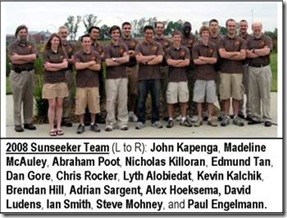The WMU 2008 Sunseeker solar car team headed to Texas last week to compete with 23 other teams in the 2008 North American Solar Challenge (NASC). The 14-member team will spend a week qualifying for the biennial, cross-country, international, intercollegiate 2,400-mile race set for July 13-22, 2008, from Texas to Calgary, Canada.
The Sunseeker team designed and built this year’s entry using state-of-the-art technology. Team captain David Ludens, who graduated in April, said this year’s car is lighter, has improved motor controllers, and features a “brand-new generation of batteries.” The car also has improved aerodynamics, and the driver’s seat has been adjusted to allow the driver to sit up to drive.
Unveiled in a ceremony in front of the CEAS Parkview Campus the day before the team left for Texas, the 2008 car is different from past entries. The new Sunseeker is white and has front-wheel drive. Although it still has four wheels, the back ones are about one foot apart so that the car functions as a three-wheeled vehicle. The second rear wheel adds stability and safety.
This year’s team advisors are Abraham Poot, engineering lab coordinator for both Department of Industrial and Manufacturing Engineering and of Mechanical and Aeronautical Engineering, and John Kapenga, associate professor in the Department of Computer Science.
The 2008 NASC is sponsored by Toyota and Crowder College. The race has stops and checkpoints in seven US and five Canadian cities: Plano (just north of Dallas), Texas [start of the race]; McAlester, Okla.; Neosho, Mo.; Topeka, Kan,; Omaha, Neb.; Sioux Falls, S.D.; Fargo, N.D.; Winnipeg, Manitoba; Brandon, Manitoba; Regina, Saskatchewan; Medicine Hat, Alberta; and Calgary, Alberta [the finish line].
Eight American solar challenges have been held since 1990. In 2005 WMU’s solar car entry finished in sixth place and won the competition’s “Aesthetics” award.
2008 Sunseeker Tech Specs: The 2008 Sunseeker vehicle weighs 240 Kg; it’s five meters long, 1.8 meters wide and 1.2 meters high. Its motors include 2 CSIRO hub motors, 4.5 KW each, and front wheel drive. Its solar cells feature Emcore triple junction gallium arsenide with a peak output of 1500 W. The vehicle’s 29 Kg Battery pack consists of 520 Lithium Polymer cells with 5.3 KWhr capacity. The chassis features a chromemoly roll cage with carbon fiber bottom shell and fiberglass array shell. The car has a dual hydraulic braking system with Hayes four-wheel disks. It has four G.H. Craft carbon fiber wheels with Bridgestone Ecopia 2.5 x 14 tires.

![clip_image002[7]](http://lh6.ggpht.com/WMU.IME/SI4wKr7RtPI/AAAAAAAAAmc/7Da-RxRzy2E/clip_image002%5B7%5D_thumb%5B1%5D.jpg?imgmax=800)



